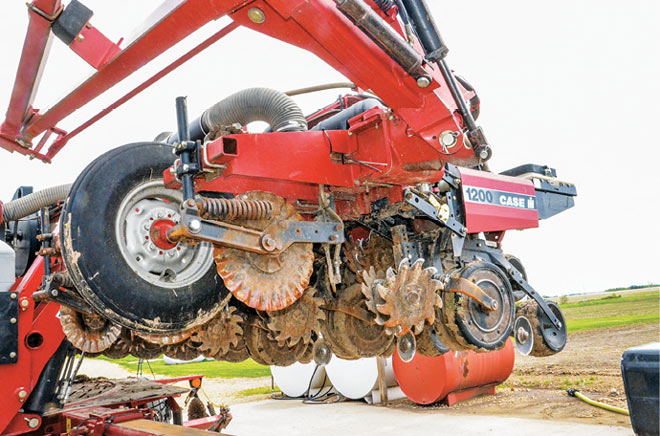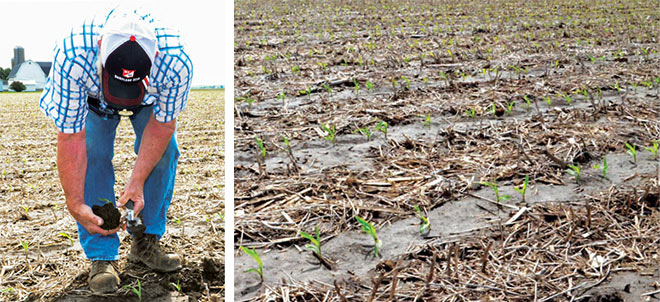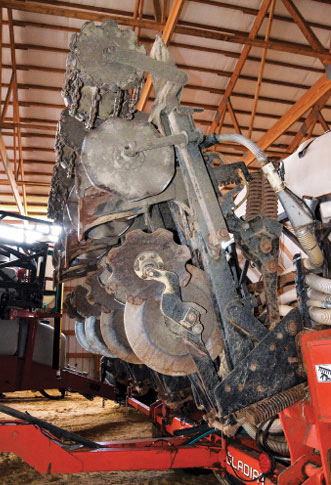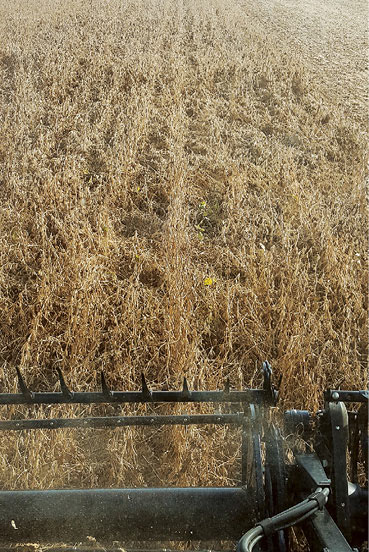Pictured Above: A GROWING OPERATION. Equipped with flow sensors and an NH3 monitor, Mike Cerny’s Kuhn Krause Gladiator strip-tilled 3,000 total acres across 10 custom fields in 2017, numbers that are set to expand with each coming year.
In a farming career spanning over four decades, not much fazes Mike Cerny at this point. From downturns to data and drones, the “combo-tiller” knows better than to get carried away with any given industry ‘breakthrough,’ although he is always willing to at least give one a try.
“I tried out field mapping from the very beginning,” Cerny says with a smile as he strolls through the equipment shed on his Sharon, Wis., farm. “The first GPS receiver I ever bought had the serial number ‘002.’”
His commitment to learning by doing through the years has helped shape Cerny’s multi-faceted approach for success in a three-crop rotation of corn, soybeans and wheat. Through seed research, tillage methodology and equipment optimization, he has created a foundation of flexibility and a willingness to adapt.
More Methods, More Yields
After years of strictly no-tilling all of his crops, Cerny first experimented with strip-till about 10 years ago when a neighbor did some custom work on Cerny’s acres. Pleased with the yield and moisture-retention on the trial acres, Cerny bought his first strip-till rig, a Kuhn Krause Gladiator, 6 years ago. Today, he strip-tills 2,000 custom acres for 10 different farmers, and 3,000 total acres across his entire operation.
Cerny originally used strip-till for his commercial corn only, but in the past 5 years he has added soybeans. This strategy, he notes, is unusual for many strip-tillers in his region, yet effective for his acres. After trial and error, Cerny has settled on an 8-inch wide strip for both crops on most acres, experiencing improvements to both yields and planting date flexibility along the way.
“The first GPS receiver I ever bought had the serial number ‘002...’”
In 2016, Cerny’s strip-tilled acres averaged 230 bushels per acre for corn and 75 bushels per acre for soybeans.
“On the corn side, I can pick up as much as 20 bushels per acre with strip-till vs. no-till, depending on the growing season among other variables,” he says. “On the soybean side, I can pick up more than 4 bushels per acre.”
Cerny will typically build his strips in the fall, with corn being the top priority. The timing of harvest along with weather variance determines if he has time to build the strips intended for soybean planting as well.
“Spring can be wet and cool, but sometimes I don’t have the time in the fall to get out there to build the strips prior to when I should be planting,” Cerny says. “When the soil is wet, I’m not going to be able to make a nice mound, plus I’m going to create issues with compaction. So it’s a higher risk.”
Searching for Value in Seed Selection, Performance
Crucial to the process is getting the best seed attainable, and for Mike Cerny, this involves a unique approach to his commercial corn, soybeans and wheat acres.
“For corn yields, I think a lot of it is variety,” Cerny says. “We’ve come so far with hybrids and we’re all used to this 220-230 bushel corn. If we have a bad year and get closer to 175, we’re going to be disappointed because we’re just not used to that anymore,” Cerny adds with a laugh.
When it comes to soybeans, his agreement to collaborate with the soybean seed company Dairyland Seed gives him a edge on testing the latest genetic hybrids.
“My soybeans from the seed company are always the newest varieties,” he says. “I’m a year or 2 ahead of what the commercial grower on the soybean side for seed can attain.”
On the wheat side, a contract with Wisconsin Foundation Seeds provides Cerny with certified seed varieties developed by the University of Wisconsin among other public universities. Similar in quality to varieties from private entities, the seeds he plants are competitive in performance with higher-profile varieties in the market at a significantly cheaper price.
“The newer variety I’ve been growing finished in the top 10 last year out of hundreds of varieties,” Cerny says. “It’s a strong mix at about half the price.”
Cerny also runs a seed cleaning operation where he treats and bags the varieties himself to add additional value. Between bagging the seeds and conducting the research, Cerny’s vision of a multi-crop operation has come to fruition for the past 20 years.
“At minimum, I can save $30 an acre through the public varieties route once I add a little bit of profitability into the whole thing,” Cerny says.
When the strips are properly built, the soil will warm up and dry much quicker after reacting to the fertilizer in the roots, providing a higher-quality and more accessible seedbed for Cerny to utilize. He’s been using a Case IH 1200 PT planter for the past several years, equipped with a 12-row configuration for corn and 23 rows for soybeans. He recently acquired, however, a new Case IH 2150 and intends to use a 16-row setup for both corn and soybeans.
“I can get out into the field maybe 4-to-5 days earlier than with no-till, because I always had the residue to deal with and it was always wetter and cooler,” he says. “With strip-till, I can typically get right out there and start planting.”
Cerny also notes his strip-tilled crops tend to have a stronger structure than the no-tilled crops. One soybean field he worked on, in collaboration with the University of Wisconsin, planted alternating strip-till and no-till crops row-by-row across 60 acres. The ongoing project provides a direct compare and contrast opportunity of the methods.
“The visible difference there is just unbelievable. The strips are standing up tall and straight, while in no-till, the crops are laying down,” he says. “The strip-tilled crops look healthier and there appears to be less disease, but appearance doesn’t necessarily transfer to yield, which was interesting. We’ll know more about that when we get the results back from the university.”

DEEP-SEEDED SUCCESS. The warmer and drier strip-tilled soils provide a higher-quality seedbed for Mike Cerny’s Case IH1200 PT planter.
As for his choice of strip-till rig, Cerny settled on the Gladiator, equipped with flow sensors, an NH3 monitor and factory row units. He choose the Gladiator because other options weren’t as heavily built, contributing to failures with consistent ridge formation for the strips. In addition, the minimal grease fittings on the row units and 50-hour grease fittings for the walking tandems on the wings of the rig require minimal maintenance on a week-to-week basis

BUSHEL BOOM. Settling on an 8-inch strip for most acres, Mike Cerny predicts or sees yield improvements of 20 bushels per acre with corn and 4 bushels with soybeans vs. no-till in a typical growing season.
“Some of these guys tell me it takes 3 tubes of grease to lubricate their machines, and that’s an every 10 hour job, so once a day basically,” he says.
Fertilizer Frenzy
“I can get out into the field maybe 4-5 days earlier than with no-till, because I always had the residue to deal with and it was always wetter and cooler...”
To hedge his bets for optimal yield, Cerny has been applying several forms of N into his commercial corn, including an encapsulated application in the fall for the past 3 years. His investment in encapsulated N is based on the slow-release function of the fertilizer, which in theory will introduce nutrients in valuable increments to the crop as needed (instead of risking excess nutrients with insufficient or mistimed applications).
The benefits have shown decreased groundwater contamination, which Cerny has been concerned about in the past. Whether or not the encapsulated N will be a long-term fertilizing practice remains to be seen, given it’s one of the costlier sources of N.
For soybeans, Cerny finds potash to be the most responsive choice while also avoiding the risk of excessive N from other options. Whens soil tests show deficient levels of phosphate, Cerny applies diammonium phosphate (DAP) as needed, but adds that doing so is less out of preference, but necessity.

FORTIFIED RELIABILITY. The heavier build of the Kuhn Krause rig allows for better consistency with ridge formation on the strips while requiring less maintenence than other options, Mike Cerny says.
“We can’t get the triple super phosphate anymore, and we wish we could because we could eliminate the N we don’t want in the groundwater,” he says. “Unfortunately, we don’t have that choice at the moment.”
Regardless of fertilizer type, Cerny approaches nutrient levels individually for each field, understanding there there’s no magic number that can be universally applied. On corn for example, Cerny averages 170 pounds per acre for N, 175 pounds per acre for potash and 125 pounds per acre of DAP, but he emphasizes how neighboring fields can have significant differences in soil fertility and response to N, potash or DAP.
“I need to figure out what I took off from last year’s cop, what I expect to take from this year’s crop, analyze the soil tests, and then determine fertilizer amounts,” he says. “Very seldom is it less than 150 pounds, and very seldom is it over 400 pounds. The type of crop plays a vital role as well.”
Yielding on Maps
Cerny has used some variation of soil fertility mapping for the past 15 years, but has recently slowed adoption of the technology to an extent. Part of his rationale comes from the need to commit to a specific starting point when measuring the fertility of a field on a map. Picking the best starting point is a conversation clouded in debate to this day.
“After viewing some of the data for the first time, we put drain tile in and turned some of the worst-yielding places in the field into the best...”
“When you look at a yield map and want to decide what areas need specific fertilizer and requirements, then you are using the yield map for the basis of everything you do,” Cerny says. “Some say to categorize it by soil type, others say to measure it by total soil fertility and still others say to strictly measure results based off of previous yield history.”
If he were required to choose one of the aforementioned options, Cerny would lean toward previous yield history since its been used as a key benchmark in the past. When looking at the big picture, though, Cerny would prefer not committing to one reference point when analyzing fertility or yield.

SIDE BY SIDE. When planted in an alternating row-by-row fashion, the strip-tilled soybeans had a stronger build and appeared heathier than the no-tilled soybeans across the 60-acre field.
“Developers have refined those systems enough now that they categorize by regions, and that is probably very beneficial, but yield history normally tells me what it’s capable of. Then I know what I’m taking off for fertilizer so I can put that dosage of fertilizer back on,” he says. “But once I commit to one reference point with mapping, I lock myself into a box because the system tells you, ‘This is what the yield is.’ Well how do I know the yield would be the same if I added fertilizer or tried something different for a year?”
Cerny does point out the initial value provided when it came to refining some of his acres based off collected and analyzed yield data. From tree lines to fencing, Cerny hadn’t realized the extent to which subtle irregularities and borders on a field could disrupt the yield of an entire field.
Through the initial information provided by the yield maps, Cerny was able to pinpoint the poorly performing areas of a field and make adjustments. Although that data isn’t needed much beyond that point, he says it set the stage for consistent yield success across his enitre field going forward.
“After viewing some of the data for the first time, we put drain tile in and turned some of the worst yielding places in the field to the best because it had been fertilized all those years and never used,” he says.







